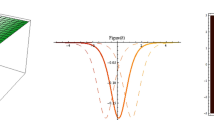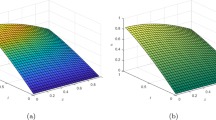Abstract
The possibility of observing the mode coupling effect, caused by a local inhomogeneity, is studied for a long-range stationary acoustic track between a single sound source and a single receiver in a shallow-water waveguide. This effect manifests itself in the form of oscillations of normal mode amplitudes in the frequency domain and can be used to localize inhomogeneities. An analytical formula linking the oscillation period of the first-mode amplitude with the distance to the inhomogeneity is proposed. Numerical experiments with a model inhomogeneity in the form of a local bottom rise show that the frequency dependence of the mode amplitude can be selected not only at a vertical line array but also at a single receiver, with the use of warping transform. In this case, the receiver depth should correspond to zero of the second-mode vertical profile. The dependence of the mode amplitude oscillations on the local inhomogeneity size is discussed.






Similar content being viewed by others
REFERENCES
W. Munk and C. Wunsch, “Ocean acoustic tomography: Rays and modes,” Rev. Geophys. 21 (4), 777–793 (1983). https://doi.org/10.1029/RG021i004p00777
B. Katsnelson, V. Petnikov, and J. Lynch, Fundamentals of Shallow Water Acoustics (Springer-Verlag, New York, 2012). https://doi.org/10.1007/978-1-4419-9777-7
V. M. Kuz’kin, Y.-T. Lin, A. A. Lunkov, J. F. Lynch, and V. G. Petnikov, “Frequency shifts of the sound field interference pattern on oceanic shelf in summer conditions,” Acoust. Phys. 57 (3), 381–390 (2011). https://doi.org/10.1134/S1063771011030092
V. M. Kuz’kin, M. V. Kutsov, and S. A. Pereselkov, “Frequency shifts of sound field maxima in few-mode propagation, which are initiated by internal wave solitons,” Phys. Wave Phenom. 21 (2), 139–151 (2013). https://doi.org/10.3103/S1541308X13020064
Y. Jiang, V. Grigorev, and B. Katsnelson, “Sound field fluctuations in shallow water in the presence of moving nonlinear internal waves,” J. Mar. Sci. Eng. 10 (1), 119 (2022). https://doi.org/10.3390/jmse10010119
M. Badiey, V. M. Kuz’kin, G. A. Lyakhov, S. A. Pereselkov, D. Yu. Prosovetskiy, and S. A. Tkachenko, “Intense internal waves and their manifestation in the interference patterns of received signals on oceanic shelf. Part II,” Phys. Wave Phenom. 27 (4), 313–319 (2019). https://doi.org/10.3103/S1541308X19040125
V. A. Grigorev, B. G. Katsnelson, and J. F. Lynch, “Bottom attenuation estimation using sound intensity fluctuations due to mode coupling by nonlinear internal waves in shallow water,” J. Acoust. Soc. Am. 140 (5), 3980–3994 (2016). https://doi.org/10.1121/1.4967852
K. G. Sabra, S. Conti, P. Roux, T. Akal, W. A. Kuperman, J. M. Stevenson, A. Tesei, and P. Guerrini, “Experimental demonstration of a high-frequency forward scattering acoustic barrier in a dynamic coastal environment,” J. Acoust. Soc. Am. 127 (6), 3430–3439 (2010). https://doi.org/10.1121/1.3418662
B. Lei, K. Yang, and Y. Ma, “Forward scattering detection of a submerged object by a vertical hydrophone array,” J. Acoust. Soc. Am. 136 (6), 2998–3007 (2010). https://doi.org/10.1121/1.4901709
A. I. Khil’ko, I. P. Smirnov, E. A. Mareev, K. A. Sidorov, V. E. Konovalov, and V. V. Kovalenko, “Detection of spatially localized inhomogeneities in refractive waveguides when probing with focused high-frequency acoustic pulses,” Radiophys. Quantum Electron. 65 (7), 496–513 (2022). https://doi.org/10.1007/s11141-023-10231-5
T. C. Yang, C. F. Huang, S. H. Huang, and J. Y. Liu, “Frequency striations induced by moving nonlinear internal waves and applications,” IEEE J. Ocean. Eng. 42 (3), 663–671 (2016). https://doi.org/10.1109/JOE.2016.2593865
A. A. Lunkov and M. A. Shermeneva, “Mode coupling due to a local inhomogeneity in a shallow-water acoustic waveguide in a broad frequency band,” Acoust. Phys. 68 (5), 467–475 (2022). https://doi.org/10.1134/S1063771022050062
A. I. Belov and G. N. Kuznetsov, “Estimating the acoustic parameters of a model of a shallow-water seafloor using a priori geological and geophysical information and the Wigner transform,” Acoust. Phys. 60 (2), 191–196 (2014). https://doi.org/10.1134/S1063771014010047
J. Bonnel, A. Thode, D. Wright, and R. Chapman, “Nonlinear time-warping made simple: A step-by-step tutorial on underwater acoustic modal separation with a single hydrophone,” J. Acoust. Soc. Am. 147 (3), 1897–1926 (2020). https://doi.org/10.1121/10.0000937
S. N. Sergeev, A. S. Shurup, O. A. Godin, A. I. Vedenev, V. V. Goncharov, P. Yu. Mukhanov, N. A. Zabotin, and M. G. Brown, “Separation of acoustic modes in the Florida Straits using noise interferometry,” Acoust. Phys. 63 (1), 76–85 (2017). https://doi.org/10.1134/S1063771016060154
M. Yu. Fershalov, P. S. Petrov, D. S. Manulchev, and A. D. Zaharenko, “A method for single-hydrophone geoacoustic inversion: Application to a waveguide with inhomogeneous bottom relief,” Underwater Invest. Rob., No. 1 (35), 51–59 (2021). https://doi.org/10.37102/1992-4429_2021_35_01_05
M. Yarina and B. Katsnelson, “Mode selection of wideband acoustic signals using time-frequency (warping) analysis for single hydrophone. Comparison with array filtering in variable medium,” Proc. 2019 IEEE Int. Conf. on Microwaves, Antennas, Communications and Electronic Systems (COMCAS), Tel-Aviv, Israel, November 4–6, 2019 (IEEE, 2020), pp. 1–4. https://doi.org/10.1109/COMCAS44984.2019.8958259
J. Bonnel, S. Caporale, and A. Thode, “Waveguide mode amplitude estimation using warping and phase compensation,” J. Acoust. Soc. Am. 141 (3), 2243–2255 (2017). https://doi.org/10.1121/1.4979057
M. D. Collins and E. K. Westwood, “A higher-order energy-conserving parabolic equation for range dependent ocean depth, sound speed, and density,” J. Acoust. Soc. Am. 89 (3), 1068–1075 (1991). https://doi.org/10.1121/1.400526
O. A. Godin, “Reciprocity and energy conservation within the parabolic approximation,” Wave Motion. 29 (2), 175–194 (1999). https://doi.org/10.1016/S0165-2125(98)00025-0
G. A. Grachev, “Theory of acoustic field invariants in layered waveguides,” Acoust. Phys. 39 (1), 33–35 (1993). https://elibrary.ru/item.asp?id=25627372
Y. Le Gall and J. Bonnel, “Passive estimation of the waveguide invariant per pair of modes,” J. Acoust. Soc. Am. 134 (2), EL230–EL236 (2013). https://doi.org/10.1121/1.4813846
Funding
This study was supported by the Russian Science Foundation, grant no. 22-72-10121; https://rscf.ru/en/project/22-72-10121/.
Author information
Authors and Affiliations
Corresponding author
Ethics declarations
The authors declare that they have no conflicts of interest.
Additional information
Translated by Yu. Sin’kov
Publisher’s Note.
Allerton Press remains neutral with regard to jurisdictional claims in published maps and institutional affiliations.
About this article
Cite this article
Lunkov, A.A., Shermeneva, M.A. Application of Warping Transform for the Analysis of the Acoustic Mode Coupling due to a Local Inhomogeneity in Shallow Water. Phys. Wave Phen. 31, 396–405 (2023). https://doi.org/10.3103/S1541308X23060067
Received:
Revised:
Accepted:
Published:
Issue Date:
DOI: https://doi.org/10.3103/S1541308X23060067




